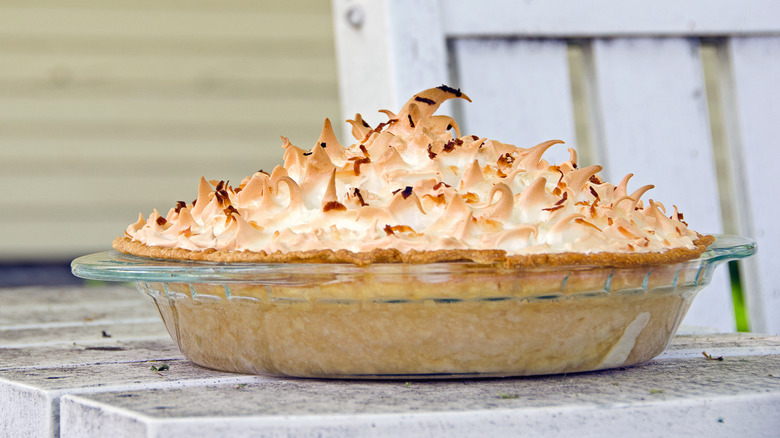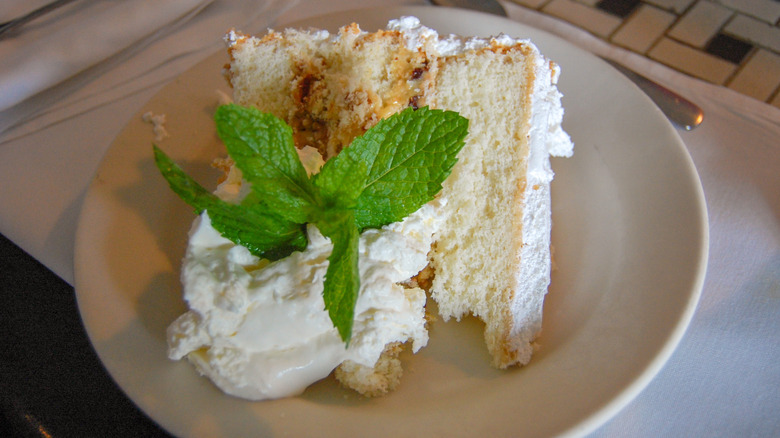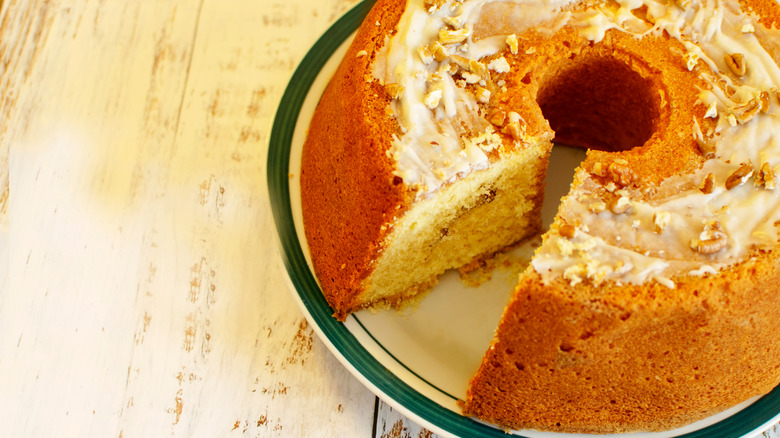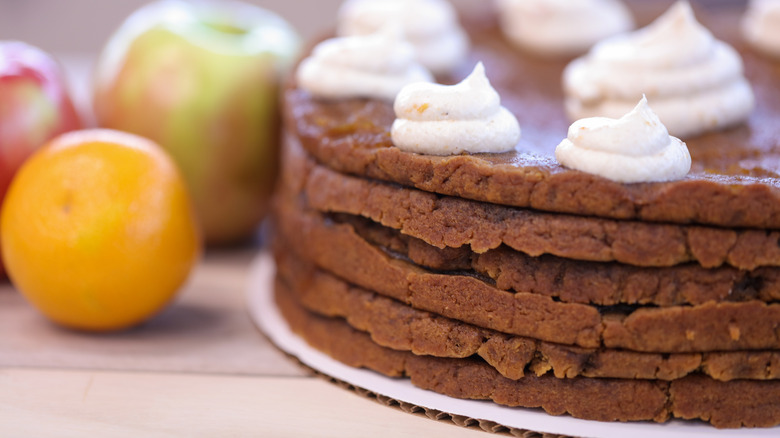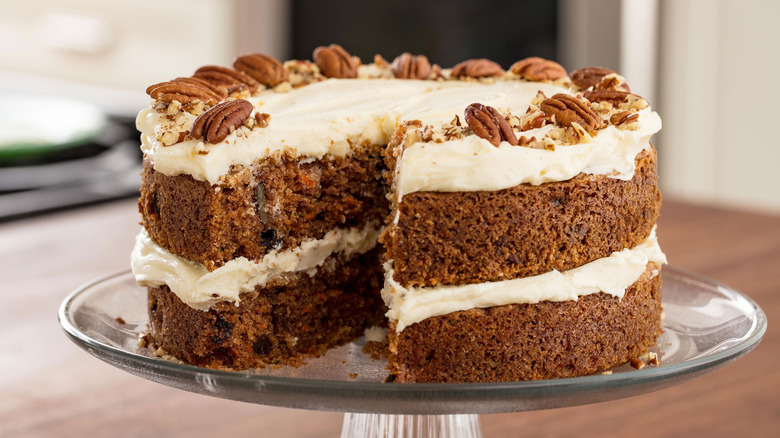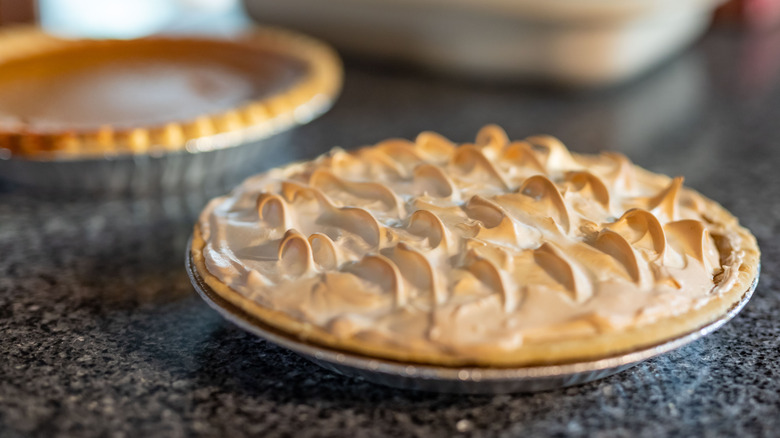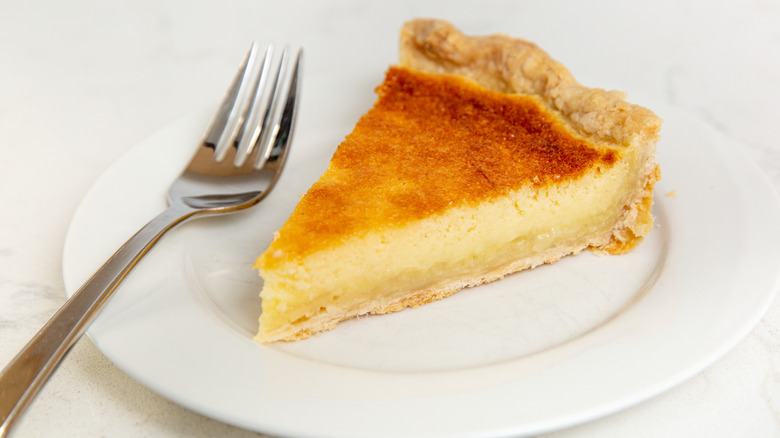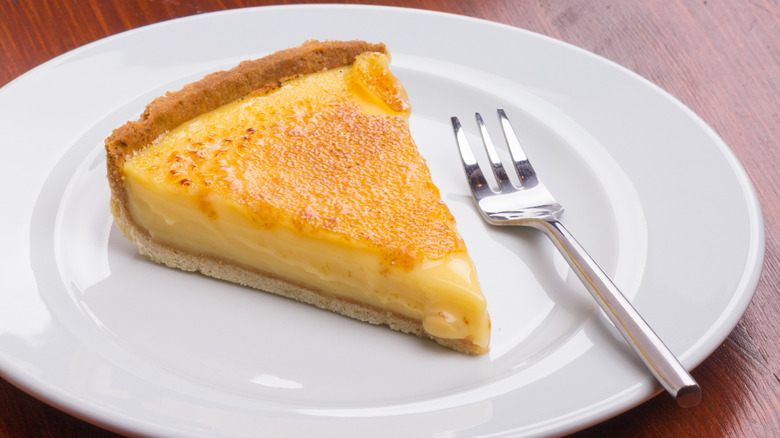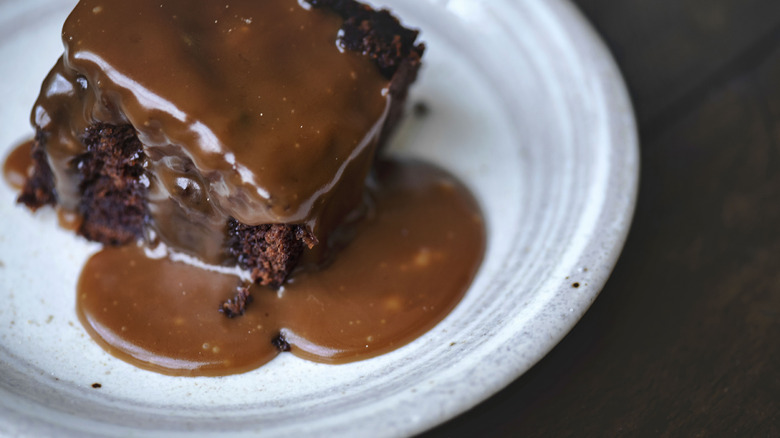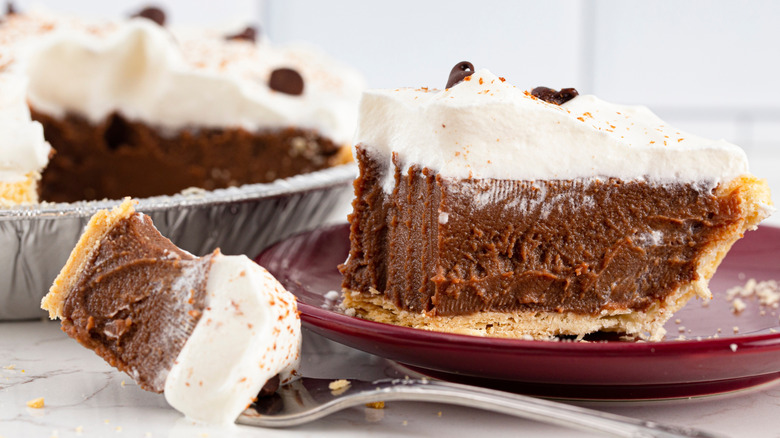Old-School Southern Desserts That Need To Make A Comeback
From sweet tea to salads with marshmallows that somehow count as side dishes, the American South has never been shy about its sweet tooth. But with so many delicious desserts, some old-school Southern sweets have been left cooling on the windowsill of history. It's time to crack open grandma's stained recipe cards, dust off those vintage cookbooks, and welcome some classics back to the table.
We'll revisit towering cakes steeped in bourbon and literary history, groove out to a Bundt cake with R&B song lyrics baked right in, and clear up transparent pie. We'll give a well-deserved nod to the citrus dessert that Key lime shoved out of the limelight and prove that vinegar belongs in pie plates just as confidently as it does on collard greens. Turns out nostalgia tastes even better with extra sugar, so let's take a tour through the South's vintage sweets pantry and admire some desserts that deserve another slice of the spotlight.
Lane cake
Lane cake takes layers of sponge cake and alternates them with a boozy filling of raisins, pecans, and coconut that's soaked in so much bourbon that you may need a designated driver. Though the recipe has evolved over the years, the cake gets its name from Emma Rylander Lane of Alabama. She wowed the judges in a baking competition and took first prize at a Georgia county fair back in the late 1800s.
Fast forward to 1961, when Harper Lee's "To Kill a Mockingbird" won the Pulitzer Prize. The novel features Miss Maudie Atkinson, who's known all over town for her bourbon-filled Lane cake. The book helped make the cake famous enough to become Alabama's state dessert, cementing the dessert's place in Southern — and literary — lore.
Yet somewhere between Prohibition and a fascination with dump cakes, Lane cake's notoriety faded. And that's a pity, because whether you cover it in whipped cream, coat it with meringue frosting, or leave it bare to let those layers shine, it's a dessert that just gets better and better with every tipsy bite.
Sock-It-To-Me cake
Back when shag carpet was still cool, Duncan Hines put a recipe for Sock-It-To-Me cake on its boxed cake mix. "Sock it to me" was the era's way of saying "give it to me" or "lay it on me." In Aretha Franklin's 1967 hit song "Respect," powerhouse backup vocals helped make the phrase iconic.
So, what's Sock-It-To-Me cake lay on you? A yellow cake baked with sour cream for extra moisture. A streusel filling made of brown sugar, cinnamon, and chopped pecans. And a sweet, drizzly glaze on top. It's like if pound cake and coffee cake had a lovechild — and decided to raise it in a Bundt pan. Trust us, Sock-It-To-Me cake tastes as good as it looks, which is why this groovy classic deserves some r-e-s-p-e-c-t.
While the early Duncan Hines recipe started with a cake mix and ended with a simple sugar glaze, the cake is really as versatile as Franklin's vocal range. Maybe you'll ditch the box, bust out a lava lamp, and make the cake from scratch. Or swap pecans for walnuts. Go nut-free with crushed graham crackers. Spice the filling with nutmeg or stir in some dried cranberries. Add maple extract or orange zest to the icing. However you mix it, one thing's for sure — serve this cake at your next gathering and your guests will be making requests for seconds.
Apple stack cake
Apple stack cake is not just a dessert, it's an experience. Multiple layers of thin cake — resembling something like a spongy gingerbread or molasses cookie — stack up with sweet apple filling. The cake has even more names than layers — Appalachian stack cake, Kentucky stack cake, Tennessee stack cake, pioneer stack cake... you get the idea.
There are even more recipes than names for apple stack cake. The cake layers are typically made with buttermilk, sorghum syrup, or dark molasses, and spices like ginger and cinnamon. The filling might be apple butter or a sweet sauce made from dried apples and brown sugar. That goodness is slathered between each cake layer — sometimes, that's just a few layers. For special occasions, you might need a step stool to reach the top. And then comes the waiting ... the cake needs to ripen for at least 24 hours. Without the wait, it's a collection of disappointingly dry disks instead of a moist, spice-infused dessert. When ready, the cake is delicious without frosting, though some like a dusting of powdered sugar or a sweet ginger glaze.
There's an old legend that apple stack cake was once a mountain wedding cake, where guests would contribute a layer to form one grand dessert. Romantic, sure, but not everyone believes that story. Given the steps and time involved, coordinating all those bakers in the pre-text-message era seems a bit ambitious. Regardless, it's definitely worth keeping the romance of this special cake alive.
Jam cake
Jam cake, also known as Kentucky jam cake or Tennessee jam cake, depending on which porch you're sitting on, is a spice cake sweetened with jam. It's traditionally blackberry jam, but strawberry, raspberry, wild berry, or whatever-berry all work fine. The jam isn't just for sweetness (though it does that beautifully) — it also keeps the cake moist and adds a rich, fruity depth that plain ole sugar can't match. And back in the day, sugar wasn't exactly overflowing on Appalachian pantry shelves. But if summer had been generous, kitchens were well-stocked with homemade jams. Jam cakes showcase resourceful Southern baking, using pantry staples and preserving techniques to create fruity flavors and delicious desserts year-round.
Along with the jam, the cake is baked with warm spices like cinnamon, nutmeg, cloves, and allspice. Some recipes also add cocoa powder for extra richness. Pecans and raisins often join in, bringing even more flavor and texture.
And the frosting on the cake? Usually a caramel frosting or icing. And as suggested in the 1906 book "How We Cook in Tennessee," it doesn't hurt to add nuts to the icing for a little extra flavor. Creative modern takes have switched up the frosting, trying out options like caramel cream cheese frosting or maple frosting. Nowadays, we can get sugar delivered same-day to our doorsteps. But that doesn't mean we should overlook preserves as an ingredient to make a dessert jam-packed with flavor.
Aunt Jule's pie (formerly Jefferson Davis pie)
Jefferson Davis Pie is a dessert with more aliases than a small-town gossip column. Flip through old cookbooks from the late 1800s and you'll find a simple custard pie flavored with nutmeg. Fast-forward to the 1995 edition of "Joy of Cooking" and the pie shows up in its Sunday best — brown-sugar custard, cream, dates, raisins, pecans, nutmeg with other warm spices, and a meringue topping. Every baker seems to have their own version of the dessert — meringue on or off, nutmeg in or out, dried fruit and nuts yes or no. The only consistent ingredient is confusion.
More confusion surrounds the pie's name – many theories exist. A 1940 story in the Springfield Daily News credits Mary Ann, an enslaved cook in Missouri, with creating the pie. After guests at a dinner party devoured the dessert, they stormed the kitchen to ask about it. "Aunt Mary Ann" reportedly told them they'd just tasted "Jeff Davis Pie." But even Mary Ann's name is up for debate — other sources call her Julie Ann or Jule Ann.
America's Test Kitchen renamed the pie "Aunt Jule's Pie" in its "When Southern Women Cook" cookbook. Honestly, "Aunt Pie" might be the safest bet, with a nod to the countless cooks who shaped Southern food, even if their names were left out of the story. Whatever you call it, grab a slice of custard pie and enjoy it in their honor.
Transparent pie
Let's clear this up right away — transparent pie isn't actually transparent, but it is delicious. The dessert started popping up in newspapers and cookbooks by the late 1800s, like "The Texas Cook Book" in 1883 and "How We Cook in Tennessee" in 1906. The ingredient lists from those recipes sound like a five-second grocery run — eggs, butter, sugar, maybe flour, maybe cream. Mix the ingredients together and bake on a pie shell — that's it. Some say transparent pie is basically pecan pie without the pecans.
That simplicity is part of the pie's charm. It shares the stage with other cupboard-survival classics like buttermilk pie, chess, shoofly, and sugar pies — desserts that prove common ingredients can yield presidential-level results. Yup, a young Harry S. Truman wrote to his future wife Bess about trying the "new brand of pie ... They called it transparent pie. Why I don't know because it looked like pumpkin and tasted like sugar and water with clay or something to give it body."
That mysterious "body" usually comes courtesy of eggs, though recipes do of course vary. Some toss in flour, while some call for heavy cream. Some top with meringue — and some are top secret, like Magee's Bakery, which was not transparent about its pie recipe. Opened in Maysville, Kentucky back in the '30s, the bakery helped make transparent pie a regional treasure. Sadly, Magee's Bakery is now permanently closed. That means it's up to the rest of us to bring transparent pie the attention it clearly deserves.
Orange pie
Long before Key lime snatched the title of Florida's official state pie, orange pie was basking in the glow of the Sunshine State. Flip through old publications and you'll see it everywhere — "The Florida Agriculturalist" (1894), "The Florida East Coast Homeseeker" (1912), and "The Florida Tropical Cook Book" (1912) are but just a few examples. In 1925, "The Florida Grower" called its recipe, quite simply, "Florida Pie." No surprise — it was orange.
But it wasn't just Florida. Orange pie was all over the South. Recipes for orange pie, often topped with meringue, showed up in "The Dixie Cook-book" (1885), "La Cuisine Creole: A Collection of Culinary Recipes" (1885), and What Mrs. Fisher Knows About Old Southern Cooking (1881). Not a single one of those cookbooks mentioned lime pie.
Worried a regular orange can't quite match the pucker of lime? If you love Key lime pie, you have to try sour orange pie, once a beloved Florida dessert. Same graham cracker crust, same condensed milk custard base — but with sour orange juice. So, how did Key lime pie steal the spotlight from sour orange pie? Condensed milk companies slapped Key lime recipes on their cans and got lime juice shelved right next to the milk. Orange pie missed that memo — and the limelight. That needs to change. Orange pie is flavorful and just different enough to make your guests say, "Wait — orange?" Help orange pie with a comeback and show Key lime it's not the only tart in town.
Vinegar pie
Mention vinegar pie at a potluck and watch the room do a collective double-take — you baked what, now? But long before the Great Depression forced frugal Southern cooks to improvise, vinegar pie was already sweet-talking its way onto farmhouse tables. Known as a desperation pie, it's the kind of dessert that proves pantry basics like vinegar, sugar, flour, eggs, and butter can pull off something delicious. The result is a custard-like pie with a smooth texture and just the right tangy-sweet balance. Think of it as a frugal version of lemon meringue.
Most modern recipes suggest apple cider vinegar, but in the spirit of a true make-do pie, go forth with whatever you have on hand — distilled white vinegar, balsamic vinegar, and even strawberry balsamic have all tastefully made their way into vinegar pies. So, when life gives you lemons, sure, make lemon meringue. But when life gives you no lemons at all, raid the pantry, grab that vinegar, and make something memorable enough to get folks talking for another hundred years.
Lady Baltimore cake
Don't let the name fool you — Lady Baltimore cake is pure Southern charm wrapped in frosting. Born (or so the gossip goes) in Charleston, South Carolina, the original was a tiered yellow cake. But modern bakers often opt for a snowy, white cake made with egg whites. Whatever the shade, this cake is all about layers — light and airy cake alternating with a rich filling of moistened fruit and nuts, wrapped in fluffy white frosting.
As one origin story goes, Alicia Rhett Mayberry baked this cake for a writer, Owen Wister. He was so enchanted that he named his 1906 novel "Lady Baltimore" after the dessert. In the book, the narrator fondly recalls his "first felicitous meeting with Lady Baltimore," describing the cake in swooning terms — and then abruptly stopping with, "I can't write any more about it; my mouth waters too much." Thanks to Wister's literary shoutout, the cake became a sensation, especially at Charleston's Lady Baltimore Tea Room. Legend has it that the tea room's grateful proprietors sent him a cake every year as a thank you. Talk about sweet royalties.
The filling hides many of this cake's delightful surprises. Recipes differ, but they often feature pitted dates, golden raisins, walnuts, honey, and rum extract (or real rum, sherry, or brandy). Combine that sweet, tangy filling with the soft cake and airy frosting, and you've got a slice that once inspired a novel. Maybe now it's time for it to inspire your next baking adventure.
Woodford pudding
A couple of quick clarifications — when we say pudding, we mean it in the British sense — basically, dessert. Not a bowl of custard. And Woodford refers to the county in Kentucky, in the heart of bluegrass country. But if your mind immediately went to Woodford Reserve, we get it. No judgment. In fact, maybe keep that bottle handy ... you'll see why.
Cooks in Woodford County have been making Woodford pudding since before the Civil War. It's a moist spiced cake that comes together with brown sugar, butter, eggs, baking soda, buttermilk, flour, cinnamon, and nutmeg. The not-so-secret ingredient — blackberry jam is mixed right into the batter. Unlike its relative jam cake, which usually gets caramel frosting, Woodford pudding gets a warm, drizzly sauce. That sauce is typically made with brown sugar, flour to thicken, water, butter, salt, vanilla, and sometimes cream — all melted into gooey perfection and poured over the cake while warm. And yes, even though we said the pudding's not named after the bourbon, some cooks do add whiskey, brandy, or sherry to the sauce.
The final product is a rich, dark cake (thanks to the blackberry jam, it looks like chocolate) with a warm, dripping sauce (or meringue). It might not have the pageantry of plum pudding, but it's a lot easier to make — and arguably way more crowd-pleasing. Woodford pudding is a classic, a comfort, and a Kentucky gem that deserves a lot more than a passing mention in the dusty corner of an old cookbook.
Black bottom pie
A buttery crust, chilled chocolate custard, and marshmallow meringue topping team up in black bottom pie, a favorite Southern dessert that's basically three amazing treats having a party in one pan. Looking over a recipe for this luxurious treat can be overwhelming. In Kathryn Tucker Windham's "Southern Cooking to Remember," the ingredient list actually ends with "more later." Because, yes, there are a lot of ingredients. But break this pie down into its three distinct layers — crust, filling, and topping — and black bottom pie becomes a delightfully manageable project. First, a solid and delicious foundation — usually a traditional graham cracker crust or something with crushed chocolate wafers, vanilla wafers, or even ginger snaps. A crunchy crust contrasts wonderfully with the creamy chocolate to come.
Next, the filling — chocolate lovers, this is your moment. Cocoa powder, melted bittersweet chocolate, sugar, milk, butter, and a bit of cornstarch for texture come together to make a silky, rich chocolate custard. It's so good it could easily stand alone as its own dessert. But why stop at great when you can have spectacular?
Finally, a cloudlike marshmallow meringue topping. Whipped egg whites and sugar get even fluffier when mixed with a gelatinous milk custard. And to really put you on cloud nine, it's spiked with rum or a splash of vanilla. Top it off with grated chocolate, a dusting of cocoa powder, or chocolate chips for that photo-perfect finish. But take a picture fast, because this decadent pie won't last.
